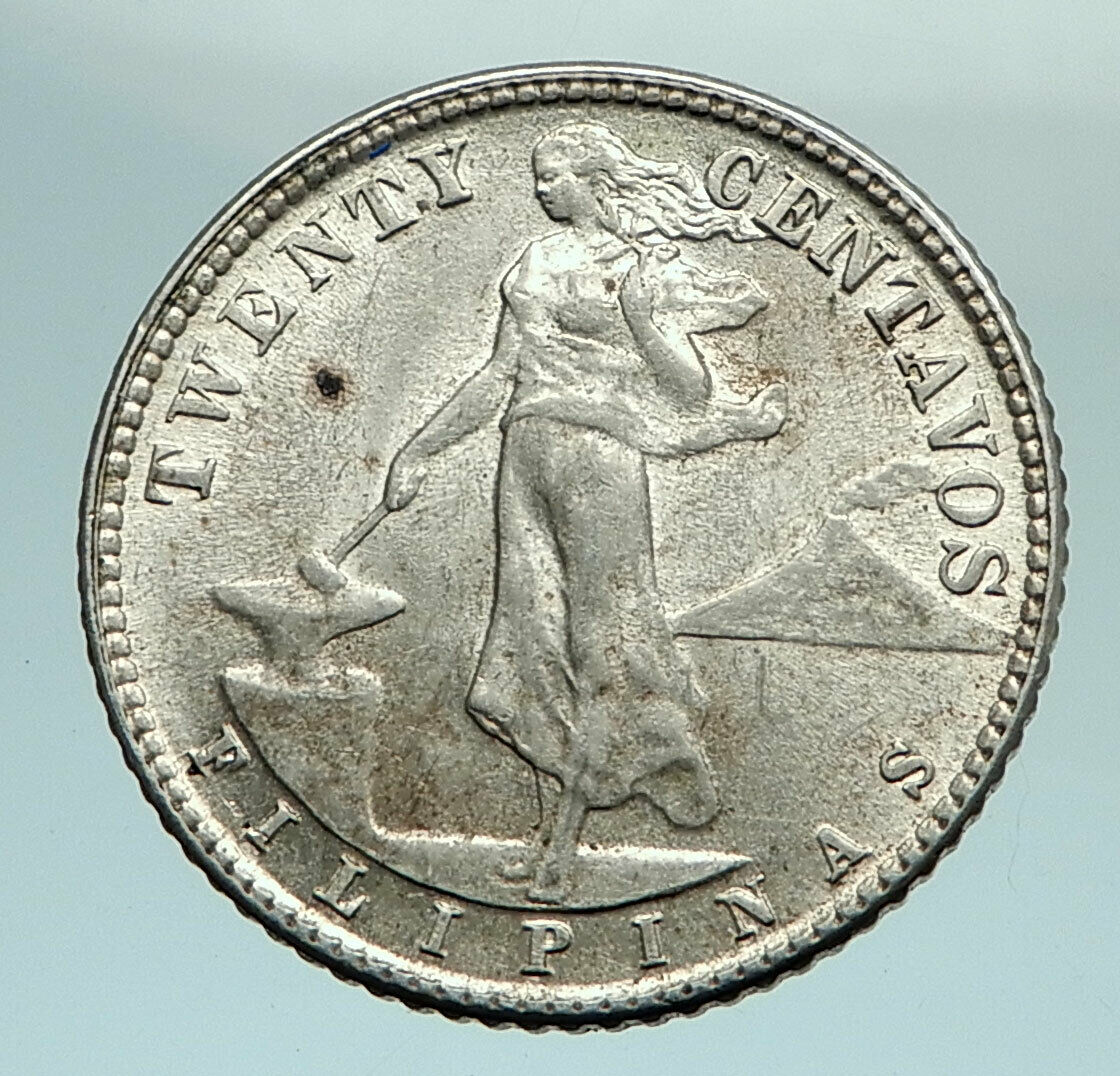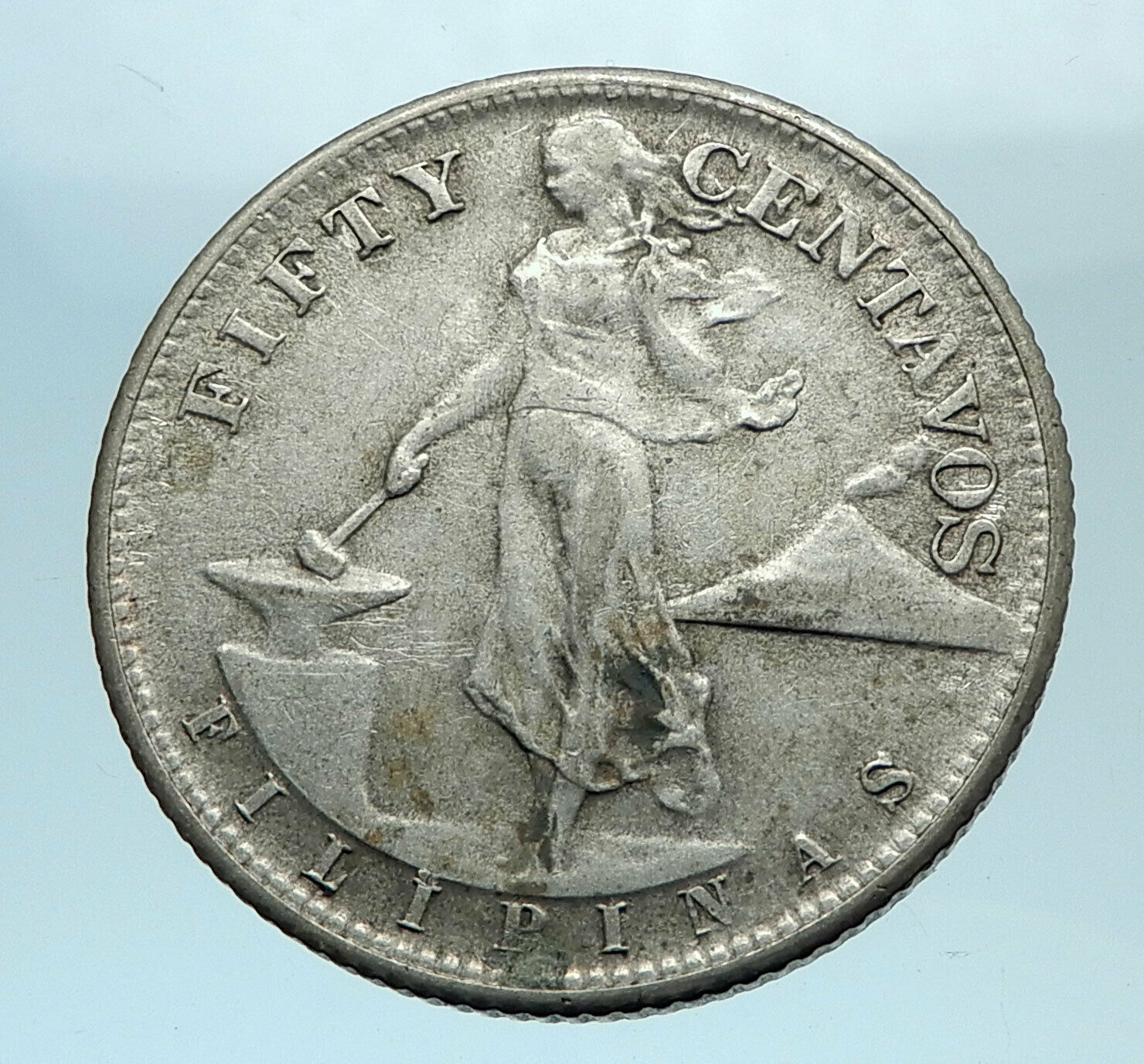|
WORLD COINS, SOUTH ASIA,
Philippines
United States Administration
1944D
Silver Ten Centavos 16mm (1.97 grams) .750 Silver
Denver Mint
TWENTY CENTAVOS FILIPINAS,
Figure of Liberty, a standing female figure (considered by many to be the
daughter of the designer ‘Blanca’) in the act of striking the anvil with a
hammer. This was done to show the work being done by Americans in building a
better Philippines. On the right side (background) there is a simmering volcano,
Mt. Mayon, topped with smoke rings.
UNITED STATES OF AMERICA D 1944, Eagle with open wings standing atop shield.
You are bidding on the exact item pictured,
provided with a Certificate of Authenticity and Lifetime Guarantee of
Authenticity.
The Elections for the Members of the Philippine Assembly were held in
the Philippines
on July 30, 1907 pursuant to the
Philippine Organic Act of 1902
in where it
prescribed the establishment of a bicameral legislature composed of the
Philippine Commission
(Upper House) and the
Philippine Assembly
(Lower House) in where the
members of the Philippine Assembly would have elections after the publication of
the Census of the Philippines which was done in 1903.
Formation of
political parties
Federalistas, Independistas and Union Nacionalistas
After the conclusion of the
Philippine-American War
(then known as the
“Philippine Insurrection”),
William Howard Taft
and a
United States Congress
delegation arrived in
the country and assessed the situation. The
Philippine Assembly
was subsequently created in
1902 by the
Philippine Organic Act of 1902
.
By then, divisions were created between those who advocated statehood within
the United States (the Federalistas) and those who advocated independence (the
Independistas). The opposition against American rule were unable to mount a
united front for the
1906 local elections
, with only the Comitė de
Intereses Filipinos presenting a united, yet limited, organization that sought
to influence the elections. By mid-1906, those in opposition to American rule
began organizing themselves into political parties.
The merger of the Comitė de la Union Nacional and the Partido Popular
Independista created the Partido de la Union Nacionalista. The Union
Nacionalistas deferred the hardline path and instead settled in an evolutionary
position. Meanwhile, the Independistas urged on a platform of immediate
independence from the U.S. After failing to broker a deal with the Independistas,
the Union Nacionalista proposed a merger with the Federalistas.
Juan Sumulong
, who led the Federalistas,
advocated a radical policy, more in line with the “conservative” wing of the
Union Nacionalistas led by
Rafael Palma
. The Federalistas consulted
Governor-General
James Francis Smith
, who then sought to advice
of Taft on the matter. Both Smith and Taft opposed the union, with Smith saying
to Sumulong that a fusion will “result in the complete obliteration of the
conservative element as a political actor in the community.” The refusal of
Federalistas reopened talks between the Union Nacionalista and the
Independistas.
The Independistas organized themselves in January 1907 with a leadership
election. To prevent further split,
Alberto Barretto
and
Justo Lukban
were elected co-leaders of the
party. The election of
Fernando Guerrero
,
Sergio Osmeña
,
Teodoro Sandiko
and
Isauro Gabaldon
as counselors marked the first
time that a Manila-based political group established links with provincial
leaders.
The
Nacionalistas and the Progresistas
In late January, the Federalistas organized themselves into a new name,
Partido Nacional Progresista and launched a campaign to win seats in provinces
around Manila. The nationalist-leaning groups launched negotiations to present a
unified slate in the elections; Meanwhile, Palma insisted on having the word “Immediata”
(immediate) to the party name of the proposed merger of the Union Nacionalistas
and the Independistas. On March 12, 1907, the Union Nacionalista and the
Independistas merged to form the
Partido Nacionalista
.
While the Nacionalistas will have a rotating leadership, the manner of
selection of the candidates was a source of major dispute and the party
convention at the
Manila Grand Opera House
ended in disarray. The
Progresistas, on the other hand, dropped Federal from the party name seeing that
the word had outlived its usefulness and had changed their name to Partido
Nacional Progresista (National Progressive Party).
Campaign
While the Nacionalistas were in disarray, the Progresistas orchestrated a
well-organized “popular assembly”. The Progresistas established networks on
local strongmen on already associated with the Nacionalistas; however, they were
only able to field candidates in half of the districts in Central and
southwestern Luzon. The Progresistas were unable to recruit supporters even in
places were a Progresista is in office, save for
Tarlac
. In Manila, the Progresistas resorted to
encouraging Americans to register and vote for them. However, the Federalistas
were able to field in candidates in far-flung areas in Visayas and Mindanao.
While the Progresistas were having a hard time on increasing their ranks,
they instead relied on a strategy that will ensure the defeat of Nacionalistas
candidates that will oppose Progresista policies.
The Nacionalistas split their ranks when Guerrero and Lukban, members of the
old Independista group were dropped from the ticket in favor of
Dominador Gomez
and
Felipe del Pan
. Quezon, brokered a deal that
set a party convention that will settle candidacies but it was never convened;
Gomez and del Pan remain the official candidates for the “regular” Nacionalistas.
Guerrero and Lukban ultimately set up the Liga Nacional Independecia whose sole
purpose is to contest 1907 elections.
The Progresistas led by
Trinidad Pardo de Tavera
, on the other hand,
opposed “immediate” independence. The reception at Progresista political rallies
were from lukewarm to hostile, with people heckling “Hang them, kill them”.
On election day, the Partido Nacionalista, with its national organization in
disarray, was able to field a candidate in 68 of the 80 districts.
Results
e
• d Summary
of the 30 July 1907
Philippine Assembly
election results
| Parties and coalitions |
Popular vote |
Seats won |
| Total |
% |
Total |
% |
| |
Nacionalista
|
34,277 |
35.2% |
59 |
73.8% |
| |
Progresista
|
23,234 |
23.9% |
16 |
20.0% |
| |
Independents
|
22,878 |
23.5% |
4 |
5.0% |
| |
Other (incl. Catholic) |
16,862 |
17.3% |
1 |
1.3% |
| Total |
97,251 |
100.0% |
80 |
100.0% |
Source: Philippine Legislatures: 100
Years by Cesar Pobre |
Aftermath
Main article:
1st Philippine Legislature
While the candidates representing the Nacionalistas won majority of the seats
in the assembly, the maneuvering to the election for the
Speaker of the Assembly
began, as the Speaker
would be the most powerful Filipino in government. Quezon and Osmeña focused on
aggregating the delegates around Osmeña’s leadership, a task that became easier
than the two had anticipated. With less than two dozen delegates, the
Progresistas won’t be able to elect a Speaker from their ranks and were
marginalized from the talks amongst the Nacionalistas. Osmeña found two
opponents for the Speakership: Gomez who defeated Lukban by 31 votes, and
Pedro Paterno
. However, Gomez’s citizenship was
questioned, and Paterno found himself to be Osmeña’s leading opponent.
Gomez was found to be a Spanish citizen and a new election for his seat was
called. Gomez still ran in the election and beat Lukban by a larger margin,
about 400 votes. Gomez was permitted to take his seat, but not after seven
months has passed, and after Osmeña was elected Speaker on October 16, 1907,
with Quezon as the majority floor leader.
The defeat of the Progresistas in the elections hastened their downfall; the
Nacionalista Party will continue to dominate the elections for the legislature,
and the Progresistas, and later their successor the Democratas, will remain in
opposition.
|








